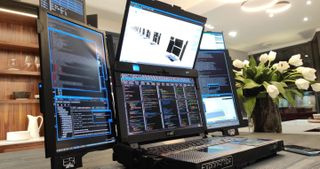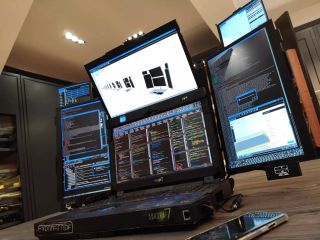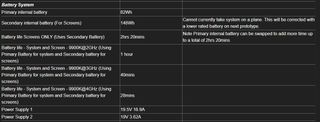This laptop has 7 screens, for when 6 isn't enough
Your scientists were so preoccupied with whether or not they could, they didn’t stop to think if they should.

What the hell. What. In. The. Absolute. Hell.
What is going on at Expanscape, the British hardware company that showed off the Aurora 7 prototype laptop today with one two three four five six seven screens. Ambitious PC gamers might have three monitors on their desk, but Expanscape apparently decided that's woefully inadequate. True productivity requires seven screens, and no fewer.
The Aurora 7's screens fan out from its main panel in a truly absurd configuration that reminds me of those early 1900s aircraft with like, 18 wings. The Aurora 7, at least, looks a bit more stable, though I haven't seen what happens if someone tries to pick it up.
In total, it's packing four 17.3-inch screens, all 4K, and three more 7-inch screens at 1920x1200. In the photographs, those mini displays are packed with data that I'm pretty sure would be impossible to read when actually using this laptop. I mean, you can't sit too close to the screens, or their combined glow would surely melt a way the surface of your eyeballs. They seem better suited to endlessly playing gifs or cat videos on loop.
The Aurora 7 is running on a "heavily modified" laptop chassis with an i9-9900K CPU, a slightly older model that should nevertheless be plenty powerful for the work scenarios envisioned here for data scientists or stock traders. The prototype is running all of those displays off a single Nvidia GTX 1060 GPU, which sounds, uh, not quite adequate. Seven screens, yet you still won't be able to run Crysis on more than one of them.

I'm trying to imagine what it would be like to game on this system, even if it was outfitted with a more capable graphics card. There are a few games out there with multimonitor support, but I don't think they're stretch well across the four main screens. I could imagine some sims being brilliant if it was possible to configure how they used the screens, though. You'd really feel like the captain in a game of Artemis Spaceship Bridge Simulator.
Most gaming laptops are pretty meager when it comes to battery life, but the Aurora 7 makes them look like e-readers by comparison. It has primary and secondary batteries for running the system and all of its displays, and one of those batteries is apparently so serious you can't take the existing prototype on an airplane. If you run the system underclocked, you can get a whole hour of life out of the thing, but crank that 9900K up to 4GHz and you're looking at 28 whole minutes of power.
The biggest gaming news, reviews and hardware deals
Keep up to date with the most important stories and the best deals, as picked by the PC Gamer team.

The Aurora 7 is just a prototype, of course, and apparently not a new one. Expanscape was tweeting about it in early 2020, and has a listing on its website for the v3 model, which will support the AMD 3950X and Intel i9-10900K processors, as well as RTX 20-series GPUs. Who knows if the system will ever go into real production, or what it'll cost when it's mass produced.
I have to say, though, I admire the confidence on display here: On its website, Expanscape says it "will be manufacturing and selling and leasing our prototypes even before they are finalised as we recognise there is an immediate demand for these items in the DevOps, SecOps, CyberSecurity and Day;Stock;Commodity Trader communities." There's even a whole page dedicated to how much the Aurora 7 costs which never actually mentions what it costs, though it does state "Pricing will reflect the costs and development involved and the fact that we are in the very early stages of our prototype's development" which I'm pretty sure is a long way of saying very expensive.
Thanks, Gizmodo.

Wes has been covering games and hardware for more than 10 years, first at tech sites like The Wirecutter and Tested before joining the PC Gamer team in 2014. Wes plays a little bit of everything, but he'll always jump at the chance to cover emulation and Japanese games.
When he's not obsessively optimizing and re-optimizing a tangle of conveyor belts in Satisfactory (it's really becoming a problem), he's probably playing a 20-year-old Final Fantasy or some opaque ASCII roguelike. With a focus on writing and editing features, he seeks out personal stories and in-depth histories from the corners of PC gaming and its niche communities. 50% pizza by volume (deep dish, to be specific).
Most Popular






